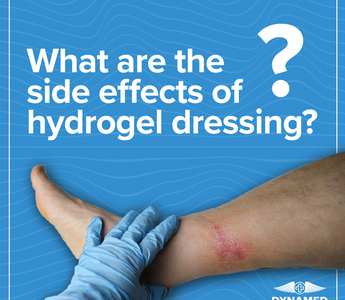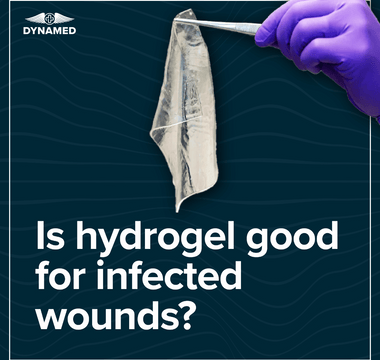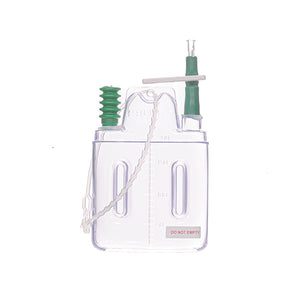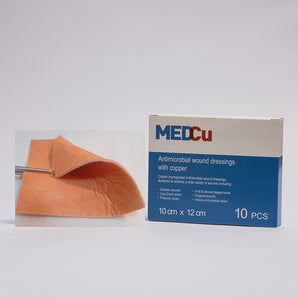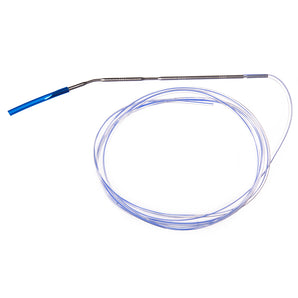Hydrogel dressings have become a cornerstone in modern wound care, valued for their ability to maintain a moist healing environment and soothe discomfort. While their benefits in managing various wound types are well-documented, it's equally important to understand any potential side effects they may pose. Knowing these can help ensure safe and effective use in both clinical and home settings.
As with any medical device, hydrogel dressings might not be suitable for everyone. Factors such as skin sensitivity, infection risks, or improper application could lead to adverse reactions. By exploring these side effects, we can better equip ourselves to make informed decisions and optimise wound care outcomes.
Key Takeaways
-
Hydrogel dressings are effective in maintaining a moist healing environment and promoting wound recovery but may cause minor side effects.
-
Potential side effects include skin irritation, allergic reactions, delayed healing, infection risks, and excessive moisture leading to maceration.
-
Proper usage, including regular dressing changes and sterile application techniques, is essential to minimise adverse effects.
-
Patient-specific factors such as skin sensitivity, immunity, or chronic conditions can influence the effectiveness and risk of side effects.
-
Monitoring wound progress and seeking healthcare guidance ensures optimal results and safe application of hydrogel dressings.
-
Selecting high-quality hydrogel dressings, tailored to individual needs, enhances wound care outcomes while reducing risks.
Understanding Hydrogel Dressings
Hydrogel dressings are advanced wound care solutions designed to maintain a moist healing environment. These dressings consist of hydrophilic polymers, such as polyvinylpyrrolidone or polymethacrylate, and typically contain 90–95% water. By interacting with wound exudate, they help hydrate dry tissue and facilitate autolytic debridement where necrotic tissue needs removal.
They come in two primary forms: amorphous hydrogels and hydrogel sheets. Amorphous hydrogels conform to irregular wound shapes, while sheets offer structural integrity for flat, superficial wounds. Both types contribute to reduced wound pain due to their gentle nature and aid granulation by promoting moisture balance.
Hydrogel wound dressings are semi-transparent and permeable to air and moisture vapour. This permeability reduces wound bed temperature and improves comfort. Additionally, their ability to exchange fluids at the wound interface traps bacteria and debris, helping create a clean healing surface. Users, however, should avoid applying these dressings to heavily exuding or infected wounds as this may limit effectiveness.
Dynamed Pharmaceuticals provides innovative hydrogel wound dressing solutions tailored to the diverse needs of healthcare settings in Africa. By ensuring flexibility, patient comfort, and advanced performance, these dressings contribute significantly to optimising recovery outcomes.
Common Uses Of Hydrogel Dressings
Hydrogel wound dressings provide effective hydration and pain relief for various wound types. They are specifically designed to suit scenarios where maintaining a moist healing environment is crucial for recovery.
Applications in Wound Care
-
Pressure Ulcers: Effective for managing pressure ulcers as the moisture promotes granulation and prevents further tissue damage.
-
Venous Ulcers: Useful for wounds on lower extremities, supporting healing through hydration and cooling.
-
Post-Surgical Wounds: Ideal for clean surgical sites by protecting tissues while regulating moisture levels.
-
Traumatic Wounds and Abrasions: Helps treat shallow injuries by soothing pain and preserving tissue integrity.
-
Donor Sites: Supports healing by maintaining moisture, reducing pain, and aiding epithelialisation.
-
First and Second-Degree Burns: Relieves pain, provides cooling effects, and ensures proper hydration to burn areas.
Suitability and Versatility
Hydrogel wound dressings are highly conformable, benefiting complex wounds and different areas of the body. Their semi-transparent nature allows easy wound monitoring without immediate removal. By donating moisture to dry wounds and absorbing minimal exudate, they strike an optimal balance for specific wound types like minimally exuding burns or ulcers.
Offering sizes ranging from 5x5 cm to 10x10 cm, and bordered variants for added support, hydrogel wound dressings align with the diverse care requirements of clinicians.
Side Effects Of Hydrogel Dressings
Hydrogel wound dressings deliver significant benefits for wound care, but they may occasionally cause minor side effects. Understanding these potential issues helps ensure safer and more effective use.
Skin Irritation And Allergic Reactions
Hydrogel dressings can sometimes cause skin irritation, especially in individuals with sensitive skin. Allergic reactions, such as redness, itching, or rashes, may occur due to sensitivity to the dressing material. It's essential to monitor the application site for any signs of discomfort and consult a healthcare provider if symptoms persist.
Delayed Healing Or Infection Risks
Improper use of hydrogel wound dressing might increase infection risks or slow down the healing process. This occurs when the dressing isn't changed regularly or used on infected wounds. Ensuring adequate wound hygiene and following medical guidelines helps mitigate these risks.
Excessive Moisture Concerns
Hydrogel dressings provide moisture to dry wounds, but excessive moisture can macerate surrounding skin. This impacts the wound's ability to heal efficiently. Address this by monitoring the wound area and choosing dressings appropriate for the moisture level required.
Our hydrogel wound dressing solutions are designed with these considerations in mind, offering safe and effective care tailored to diverse healthcare needs.
Factors Influencing Side Effects
Hydrogel wound dressings offer numerous benefits, but their side effects depend on various external and internal factors. Understanding these factors ensures their safe and effective application.
Proper Usage Techniques
Correct usage minimises adverse reactions. Regular dressing changes prevent moisture build-up, which could cause skin maceration. Using a sterile application method reduces infection risks. Avoid applying hydrogel dressings on heavily exuding or infected wounds, as this may lead to complications. Always match the dressing type, such as amorphous hydrogels or hydrogel sheets, with the wound's characteristics to enhance outcomes.
Underlying Patient Conditions
Patients’ individual conditions impact their reaction to hydrogel dressings. Those with sensitive skin may face irritation or allergies. Compromised immunity or pre-existing infections could increase the risk of complications. In diabetic patients or those with chronic conditions, wound healing may be delayed, requiring more meticulous monitoring. Skin conditions, like eczema or psoriasis, may also react adversely to hydrogel.
Proper assessment of these influencing factors ensures the dressing's effectiveness while safeguarding patient care standards.
Mitigating Risks And Ensuring Safe Use
Understanding the proper use of hydrogel wound dressings is critical to preventing complications. To achieve this, it's essential to follow recommended practices during application and replacement. Regularly changing dressings according to wound condition is necessary to prevent maceration and bacterial growth.
Steps To Reduce Side Effects
-
Practice sterile techniques: Use clean hands or sterile gloves when applying new dressings to limit infection risks.
-
Avoid overhydration: Apply hydrogel moderately to avoid excessive moisture, which can soften and damage surrounding skin.
-
Tailor application to patient needs: Assess patient conditions like skin sensitivity or allergies before use to customise treatment.
-
Monitor wound progress: Inspect wounds frequently for signs of irritation or delayed healing and adjust care plans as needed.
Importance of Professional Guidance
Consultations with healthcare professionals help ensure hydrogel dressings are appropriate for specific wounds. For certain cases, clinicians might recommend products from trusted providers like Dynamed Pharmaceuticals, which offer innovative and safe solutions. Incorporating such quality medical products can significantly improve wound care efficacy.
Conclusion
Hydrogel dressings represent a remarkable advancement in wound care, offering hydration, pain relief, and enhanced healing for various wound types. While their benefits are significant, understanding potential side effects and proper usage is vital to ensure safety and effectiveness.
By tailoring applications to individual needs and seeking professional guidance, we can optimise outcomes and minimise risks. With trusted solutions like those from Dynamed Pharmaceuticals, we’re better equipped to provide high-quality care across diverse healthcare settings.
Visit Dynamed Pharmaceuticals
Phone: 0861 00 00 43
Website: dynamed.co.za
Email (Sales): sales@dynamed.co.za
Email (Info): info@dynamed.co.za
Google Maps: Find us here
Frequently Asked Questions
What are hydrogel dressings used for?
Hydrogel dressings are used to create a moist environment for wound healing, which helps hydrate dry wounds, relieve pain, and support granulation tissue growth. They are suitable for burns, pressure ulcers, venous ulcers, post-surgical wounds, and other complex wounds needing hydration.
Are hydrogel dressings safe?
Hydrogel dressings are generally safe when used correctly. However, improper use or applying them to infected wounds may increase infection risk or delay healing. Individuals with sensitive skin should also check for possible allergic reactions.
How often should hydrogel dressings be changed?
Hydrogel dressings should typically be changed every 1–3 days, depending on the wound condition and manufacturer guidelines. Regular changes help prevent maceration and bacterial growth.
Can hydrogel dressings cause side effects?
Yes, potential side effects include skin irritation, allergic reactions, or excessive moisture leading to maceration of surrounding skin. Proper usage and monitoring can minimise risks.
What is the difference between amorphous hydrogels and hydrogel sheets?
Amorphous hydrogels are flexible and conform to irregularly shaped wounds, while hydrogel sheets provide structural support for flat wounds. Both types maintain a moist environment for healing.
Can hydrogel dressings be used on infected wounds?
No, hydrogel dressings should not be used on heavily exuding or infected wounds, as they may worsen the infection. Consult a healthcare professional for appropriate alternatives.
How do hydrogel dressings promote healing?
Hydrogel dressings keep the wound moist, helping to hydrate dry tissue, remove necrotic tissue, and reduce wound pain. They also trap bacteria and debris to create a cleaner healing environment.
What precautions should be taken when using hydrogel dressings?
Ensure sterile application, avoid overhydration, and change the dressing regularly. Consult a healthcare professional to tailor the dressing to specific wound needs and monitor for any side effects.
Are hydrogel dressings suitable for sensitive skin?
Hydrogel dressings can sometimes cause irritation or allergic reactions in individuals with sensitive skin. A patch test or seeking advice from a healthcare professional is recommended.
Where can I find trusted hydrogel dressing products?
Trusted hydrogel dressing solutions are available from reputable providers, such as Dynamed Pharmaceuticals, which offers products tailored to diverse healthcare needs for safe and effective wound care.

